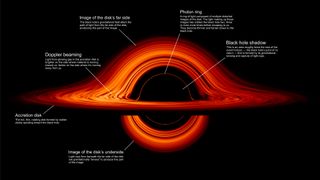Black holes on your mind? You're in luck because NASA has a new visualization showing how these immense objects work.
Black holes are regions of extremely high density that warp space around them to such an extent that it traps matter and light. If any object goes too close and enters the black hole's point of no return, called the event horizon, it cannot escape the black hole. Even light cannot move fast enough to escape a black hole's pull if it falls beyond this point.
The event horizon is so small that a single telescope cannot image it. Only after the Event Horizon Telescope united several observatories around the world did the team, working together in 2017, produced an image of a supermassive black hole within the galaxy M87, which the scientists released earlier this year.
Related: Eureka! Scientists Photograph a Black Hole for the 1st Time
The new NASA visualization shows off a more detailed view of the physics of black holes than that image could reveal. The animation displays how the black hole warps its neighborhood — just like a carnival mirror, NASA said in a statement.
As debris (such as gas) falls toward a black hole, the material clumps into a thin structure called an accretion disk. Twisting magnetic fields surrounding the disk make the gas cluster into knots, NASA said. But these knots are transient, since matter closer to the black hole orbits faster, which pulls the gas surrounding a black hole into light and dark lanes.
The visualization shows how light behaves for an observer on Earth looking edge-on at gas spinning around a black hole. In this scenario, the gas on the left side of the spinning disk appears brighter than the material on the right, NASA explained. That's because the gas on the left side is moving toward us. The light waves emanating from the left side of the disk become compacted (from our perspective) and thus appear brighter. On the right side, gas is moving away from us, so the light waves stretch out and that side appears dimmer.

(Image credit: Jeremy Schnittman/NASA's Goddard Space Flight Center)
Another way to imagine this effect, called the Doppler effect, is to picture yourself watching a car on a circular racetrack. As the car rounds one turn and faces you, its motor sounds louder because the car is moving toward you, so its sound waves get compacted. As the car rounds the opposite turn and faces away from you, its motor sounds quieter because the sound waves stretch out.
Other aspects of the physics of black holes are more difficult to imagine. For example, the visualization also shows what happens when light gets very close to the black hole. Light is made up of particles called photons. As light circles the black hole two, three or more times, it forms a photon ring. The light appears distorted, NASA explained, because the photons went around the black hole multiple times (in slightly different orbits) before escaping and reaching our telescopes or eyes.
"Simulations and movies like these really help us visualize what Einstein meant when he said that gravity warps the fabric of space and time," Jeremy Schnittman, who generated the images using custom software at NASA's Goddard Space Flight Center in Maryland, said in a statement.
Follow Elizabeth Howell on Twitter @howellspace. Follow us on Twitter @Spacedotcom and on Facebook.

Need more space? You can get 5 issues of our partner "All About Space" Magazine for $5 for the latest amazing news from the final frontier!
(Image credit: All About Space magazine)
https://www.space.com/incredible-black-hole-visualization.html
2019-09-30 11:00:00Z
CBMiPmh0dHBzOi8vd3d3LnNwYWNlLmNvbS9pbmNyZWRpYmxlLWJsYWNrLWhvbGUtdmlzdWFsaXphdGlvbi5odG1s0gFCaHR0cHM6Ly93d3cuc3BhY2UuY29tL2FtcC9pbmNyZWRpYmxlLWJsYWNrLWhvbGUtdmlzdWFsaXphdGlvbi5odG1s
Bagikan Berita Ini















0 Response to "Weird Black Hole Physics Revealed in NASA Visualization - Space.com"
Post a Comment